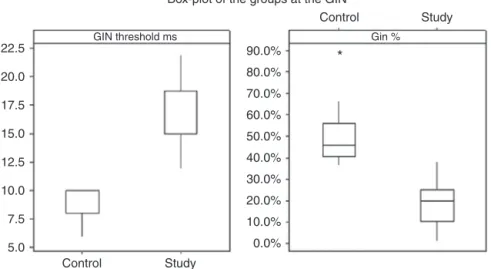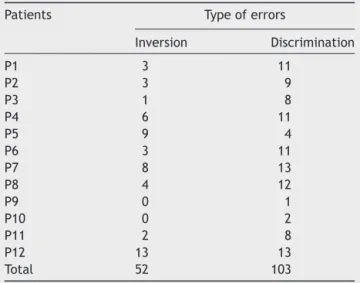www.bjorl.org
Brazilian
Journal
of
OTORHINOLARYNGOLOGY
ORIGINAL
ARTICLE
Temporal
processing
in
postlingual
adult
users
of
cochlear
implant
夽
,
夽夽
Maycon
Duarte
a,
Amanda
Dal
Piva
Gresele
a,b,
Maria
Madalena
Canina
Pinheiro
a,∗aSpecialCoordinationofSpeechTherapy,GraduateCourseinSpeechTherapy,UniversidadeFederaldeSantaCatarina(UFSC),
Florianópolis,SC,Brazil
bHumanCommunicationDisorders,UniversidadeFederaldeSantaMaria(UFSM),Florianópolis,SC,Brazil
Received5March2015;accepted12May2015 Availableonline6November2015
KEYWORDS
Cochlearimplant; Hearingtests; Adults; Hearing; Hearingloss
Abstract
Introduction:Postlingualadults demonstrate impressive performance inspeech recognition insilenceaftercochlearimplant(CI)surgery.However,problemsincentralhearing abilities remain,whichcomplicatesunderstandingincertainsituations,suchasincompetitivelistening andintheperceptionofsuprasegmentalaspectsofspeech.
Objective:ToassessthetemporalprocessingabilitiesinpostlingualadultusersofCI.
Methods:Cross-sectional anddescriptive study, with a non-probabilistic sample for conve-nience.Thepopulationwasdividedintotwogroups.Thestudygroupconsistedof12postlingual adultusersofcochlearimplantsandthecontrolgroupconsistedof12adultswithnormal hear-ing,matchedforageandgenderwiththecontrolgroup.TheFrequencyPatternTestandthe GapsinNoisetestwereselectedtoassesstemporalprocessing.Free-fieldtestingwasapplied at50dBSL.
Results:Adultusersofcochlearimplantattainedameantemporalthresholdof16.33msand scored47.7%inthepatternfrequencytest;thedifferencewasstatisticallysignificantin com-parisonwiththecontrolgroup.
Conclusion:Itwasverifiedthatpostlingualadult usersofcochlearimplantshavesignificant alterationsintemporalprocessingabilitiesincomparisontoadultswithnormalhearing. © 2015Associac¸˜ao Brasileira de Otorrinolaringologiae CirurgiaC´ervico-Facial. Publishedby ElsevierEditoraLtda.Allrightsreserved.
夽 Pleasecitethisarticleas:DuarteM,GreseleADP,PinheiroMMC.Temporalprocessinginpostlingualadultusersofcochlearimplant.Braz
JOtorhinolaryngol.2016;82:304---9.
夽夽Institution:UniversidadeFederaldeSantaCatarina(UFSC),Florianópolis,SC,Brazil.
∗Correspondingauthor.
E-mail:madapinheiro@hotmail.com(M.M.C.Pinheiro). http://dx.doi.org/10.1016/j.bjorl.2015.05.013
PALAVRAS-CHAVE
Implantecoclear; Testesauditivos; Adulto;
Audic¸ão; Perdaauditiva
Processamentotemporalemadultospós-linguaisusuáriosdeimplantecoclear
Resumo
Introduc¸ão: Osadultospós-linguaisapresentamótimodesempenhonoreconhecimentodefala nosilêncioapósacirurgiadeimplantecoclear.Noentanto,permanecemcomalterac¸õesnas habilidadesauditivascentrais,dificultandoacompreensãoemsituac¸õesdeescutacompetitiva enapercepc¸ãodosaspectossupra-segmentaisdafala.
Objetivo: Avaliarashabilidadesdoprocessamentotemporalemadultospós-linguaisusuários deimplantecoclear.
Método: Oestudofoidotipotransversal,descritivocomamostranão-probabilísticapor con-veniência. Apopulac¸ãofoidistribuída emdoisgrupos. Ogrupoestudofoi compostopor12 adultospós-linguaisusuáriosdeICeogrupocontrolepor12 adultoscomaudic¸ãonormal parea-dosconformefaixaetáriaesexodogrupoestudo.Paraavaliaroprocessamentotemporalfoi selecionadooTestePadrãodeFrequênciaeotesteGapsinNoise.Ostestesforamaplicados emcampolivreea50 dBNS.
Resultados: Osadultospós-linguaisusuáriosdeICobtiveramlimiardeacuidadetemporalmédio de16,33 msedesempenhode47,7%deacertosnotestepadrãodefrequência,sendoquea diferenc¸afoiestatisticamentesignificanteemrelac¸ãoaogrupocontrole.
Conclusão:Foiconstatadoqueosadultospós-linguaisusuáriosdeICapresentamalterac¸õesnas habilidadesdoprocessamentotemporalemrelac¸ãoaosadultossemalterac¸õesauditivas. ©2015Associac¸˜ao BrasileiradeOtorrinolaringologiaeCirurgiaC´ervico-Facial.Publicado por ElsevierEditoraLtda.Todososdireitosreservados.
Introduction
Currently,thecochlearimplant(CI)isconsideredthemost effective clinical resource to rehabilitate the hearing of patientswhohavenotbenefittedfromtheuseofan individ-ualsoundamplificationdevice(ISAD).1
PostlingualadultusersofCIhaveexcellentresultswith thedevice,andareabletoreachthemaximumscoreintests ofspeechrecognitioninsilence.2,3However,thesepatients stillpersistwithalterationsincentralhearingabilities, mak-ingspeechunderstandingdifficultinsomesituations.Among theaffectedhearingabilities,temporalprocessingisoneof themostaffectedaspects.4
Temporalhearingprocessinginvolvestheabilityto pro-cess the sound aspects that vary over time. It includes resolution hearing abilities, ordering, masking, and tem-poral integration.5 Currently, only ordering and temporal resolution abilities are routinely included in behavioral tests,becausetherearenoavailableandstandardizedtests toassesstheotherabilities.6
The temporalresolution hearing ability helpsthe indi-vidual to identify small acoustic variations that occur in the speech signal over time, and allows the perception ofsegmental,syllabic,andworddistinctionsincontinuous speech.7 This abilitycan beevaluatedthroughbehavioral testsofgapdetection.TheGaps-in-Noise(GIN)testhasbeen recommended in the current studies asa reliable tool to assess thetemporal resolution hearingability inchildren, adults,andtheelderly.8---10
Temporal ordering comprises a hearing ability that involvestheperceptionandprocessingoftwoormore hear-ingstimuliaccordingtotheirorderofoccurrenceintime.11 This ability can be evaluated through tests involving the recognition of the temporal pattern of pure tones, such
asthe Frequency Pattern Test (FPT), which is considered asensitivetooltoidentifycentralnervoussystemlesions.12 Therearesomestudiesintheliteraturesuggestingthat the temporal processing abilities are directly associated withspeechperception.13,14 Theargumentsupporting this propositionisthatmanycharacteristicsofhearing informa-tionaresomehowinfluencedbytemporalaspects.5
However,therearefew studiesin theliterature evalu-atingthetemporalprocessingabilitiesinthepopulationof CIusers.Amongtheseinvestigations,thestudiesbyDaniels andMusiek,15 ComerlattoJr.,16 andSoaresetal.17 useda standardizedtesttoassessthetemporalresolutionability. ThestudiesbyFrederigue18andCamposetal.19assessedthe hearingabilityoftemporalorderinginthispopulation.
Giventheimportanceofthetemporalaspectsofspeech, musicandreadingperception,itisveryimportanttoassess theperformanceofCIusersintemporaltests.Theseresults maysuggestabetterstrategyofCIprogramming,as tempo-ralprocessinginfluencestheaspectsoftimeanddurationof speech.Basedonthesefacts,someauthorshavesuggested newstudieswithstandardizedteststoinvestigatethe hear-ingabilitiesoftemporalprocessinginthispopulation.16
Basedontheabove,theaimofthisstudywastoevaluate thetemporalprocessingabilitiesinpostlingualadultusers ofCI.
Methods
This research followed a quantitative, descriptive, and cross-sectional approach, and consisted of a non-probabilisticconveniencesample.
Thesamplewasdividedintotwogroups:studygroup(SG) andcontrolgroup(CG).TheSGconsistedof12adultusersof CI,agedbetween24and69years,withpostlingualdeafness; theCGconsistedof12normalhearingadults.Thecontrol groupwasmatchedforageandgenderwiththeSG.
Inordertobeincludedintheprotocolandundergothe temporaltests,theSGgroupincludedCIuserswhometthe followingcriteria:lackofevidenceofneurologicalor cogni-tivealterationsthatwouldpreventtheunderstandingofthe givencommands,bilateralsevere-to-profoundsensorineural hearingloss,20 hearingthresholdsinfreefieldbetween25 and40dBHLat250---4000Hzfrequency,whowereadultCI userswithpost-lingualdeafnesswithaminimumtimeof12 monthsusingthe device, withfull insertionof electrodes inthecochlea,andforwhomPortugueselanguagewasthe firstlanguage,inadditiontoshowingspeechrecognitionin theopensetsentencetest>80%.21
TheCGincludedadultindividualswithouthearing alter-ationsthatshowednoevidenceofneurologicalorcognitive changesthatwould preventthemfrom understandingthe given commands, had bilateral hearing thresholds within the normal range,20 no complaints that could indicate alterationsinthe centralauditoryprocessing(CAP) inthe questionnaireproposed by Summers,22 andnormal results intheDichoticDigitTest.23
RegardingtheproceduresperformedbytheSG,the hear-ingthresholdswereinitiallytestedatthefrequenciesof500, 1000,2000,3000,4000,6000,and8000Hz.Thetestwas per-formedinfreefield,withthespeakersatadistanceofone meterfromthepatient,whowaspositionedat0◦azimuthin
thehorizontalandverticalplanes.Thisprocedurewas per-formedtoquantifythelevelofsensationthatwasusedin thetemporalprocessingtests.Ifthepatientwasa contralat-eralISADuser, he/shewasaskedtoremovetheprosthesis andremainonlywiththeCI.
RegardingtheproceduresperformedwiththeCG,a ques-tionnaireproposed by Summers22 was appliedto ruleout complaintsofcentralauditoryprocessingdisorder(CAPD). The normality criterion established for this questionnaire was45points.
Afterward,thehearingthresholdsweretestedatthe fre-quenciesof 250, 500, 1000, 2000, 3000, 4000, 6000, and 8000Hz, aiming to verifywhether the hearing thresholds of both ears were within the normal range according to LloydandKaplan.20 Themeasurementswereperformedin asoundproof booth,usingatwo-channeldigital audiome-ter,modelAC40,manufacturedbyInteracoustic,andWilfan TDH39earphones.
Tympanometry as well as ipsilateral and contralateral stapedialacousticreflexeswerealsotested.The tympano-metriccurves according to Jerger24 and acoustic reflexes accordingto Gelfand25 were considered normal.This pro-cedure sought to assess any middle ear involvement in the control group, which could interfere with the study outcomesandwasperformedwithanAT235acoustic immit-tancedevice,accordingtoISO389calibrationstandards.
Another procedure performed with the CG was the DichoticDigitTest(DDT),astheauthorsJergerandMusiek26 propose itsuse as a screening test to ruleout a possible
alterationinauditoryprocessing.Therefore,alladultswho hadatotalofatleast95%testaccuracywereincludedinthe CG.23 OftheCAPtests,thelatterwastheonlyoneapplied withsupra-auralphones,usingthesensationlevelof50dB HL.
Afterperformingtheabovementionedprocedures,both groupsweresubmittedtotheassessmentofauditory tem-poralprocessing.TheGIN27 andFPT28testswereused.The GINtestconsistsofthedetectionofgapsinsertedintowhite noise.Thesegapscanbeof2---6,10,12,15,and20ms.For individualswhowereunabletoidentifythemaximumgap, a22-msintervalwasassigned.TheGINtestwasappliedin ordertoassessthehearingabilityoftemporalresolution,in additiontodeterminingthetemporalacuitythresholdand thepercentageofcorrectanswers.Thetrainingtrackand thetesttracks1and2ofthecompactdiscwereused.
The FPT was used to assess the performance of indi-vidualsevaluatedregardingthehearingabilityoftemporal ordering.Inthistest,thepatientwasinstructedtonamethe tonalpatternheardinorderofoccurrence.Thestimuliwere presentedwithsixsequencesinthetrainingstageand30in theevaluationsequence.AqualitativeanalysisofFPTwas alsoperformed in ordertoverifythe mostcommon types of errorsmadeby implant users.Thesewere classifiedas inversionerrorswhenallsoundswerediscriminated,butin different orders, for instance: GAG mistaken for AGA; or asdiscriminationerrorswhenthepronouncedsoundswere replaced,forinstance:GGAmistakenforAAG.
Alltestswereperformed witha two-channel audiome-ter manufactured by Interacoustic (model AC40) coupled to a Samsungcomputer (model NP300E4C) that displayed the recorded tests.The temporaltests wereapplied in a sound-proofboothandinfreefieldat50dBSL.Patientswere placedat0◦azimuthinthehorizontalandverticalplanes.
Tests in the SG were carried out exclusively with the CI. The majority of patients hadmore than one program recorded in the speech processor. The tests were con-ductedwiththeprograminwhichthepatientshowedbetter responsesintheopensetsentencetests21andwiththe cod-ingstrategyusedontheassessmentday.
Statistical analysis was carried out with the following software:SPSSv.17,Minitab v.16,andOfficeExcel2010. ThenonparametricMann---Whitneytestwasusedtocompare theperformancebetweentheCGandSGintheGINandFPT tests. The levelof significance wasset at 5%for all tests (p≤0.05).
Results
The SG population consisted of 12 subjects, four (33.3%) malesandeight(66.6%)females.TheagerangeofCIusers rangedfrom24to69yearsofage,withameanof49years. Regardingschooling,itwasobservedthat58.3%ofpatients finished elementaryschool and only one (8.3%) had com-pletedcollege/university.
Thetables andFig.1 showthe performanceof theSG andCGintheGINtest.
22.5
20.0
17.5
15.0
12.5
10.0
7.5
5.0
90.0%
80.0%
70.0%
60.0%
50.0%
40.0%
30.0%
20.0%
10.0%
0.0%
Box-plot of the groups at the GIN
Control Study
Control Study
*
Gin % GIN threshold ms
Figure1 ControlgroupandstudygroupperformanceattheGaps-in-Noisetest.
Table1 DescriptivestatisticsoftheGaps-in-Noise(GIN)testperformanceaccordingtothegroup.
GINgroup Mean Median Standarddeviation Q1 Q3 n CI ap-Value
GINThres
CG 8.33 8 1.44 8 10 12 0.81 <0.001
SG 16.33 15 3.17 15 16.25 12 1.79
GIN %
CG 51.1% 45.8% 14.6% 42.5% 55.4% 12 8.3% <0.001
SG 19.1% 20.0% 10.0% 14.5% 22.9% 12 5.7%
CG,controlgroup;SG,studygroup;Q1,firstquartile;Q3,thirdquartile;GINThres,temporalacuitythreshold;GIN%,gaprecognition percentage.
a Mann---Whitneytest.
(p=0.001).ItisobservedthatintheGINtest,forboththe thresholdandpercentage,the CGhad betterresults than theSG.TheseresultsarebettervisualizedinFig.1.
Table 2 shows that therewasa statistically significant differencebetween theperformance ofthe groups in the FPTtest.ItisobservedthatCIusershaveworseperformance whencomparedtoadultswithouthearingimpairment.This findingcanbebettervisualizedinFig.2.
100.0%
80.0%
60.0%
40.0%
20.0%
0.0%
Box-plot of the groups at the FPT%
Control
TPF %
Group Study
Figure2 Controlgroupandstudygroupperformanceatthe FrequencyPatternTest.
Inordertobettercharacterize thestudygroup,abrief qualitativedescriptionoftheFPTresultswasconstructed, basedonthetypesoferrorsmadebythesubjects.
Itwasobservedthatofthe12testedindividuals,onlytwo showednoinversionoffrequencypatterns,andallshowed sometypeofdiscriminationerror.Themeanpercentageof inversionsintheFPTtestwas14.4%,with28.6% discrimina-tion.Otherphenomena,suchastheomissionandinsertion oftones,werealsoobservedintheFPT.
Discussion
Themechanismsinvolvedinspeechperceptionareclosely relatedtothecomplexintegrationbetweendetection, dis-crimination,recognition,categorization,sequentialshapes, andtherhythmofspeechsounds.Theprocessingof acous-tic clues from speech sounds is related to the adequate perceptionof thefrequency andduration spectraintheir orderofoccurrence,inadditiontotheperceptionofsound modificationsovertime.7,29
Table2 DescriptivestatisticsofFrequencyPatternTest(FPT)testperformanceaccordingtothegroup.
Group Mean Median Standarddeviation Q1 Q3 n CI ap-Value
FPT
CG 76.1% 78.3% 16.7% 59.2% 90.0% 12 9.4% 0.013a
SG 47.7% 43.3% 28.9% 31.6% 67.5% 12 16.3%
CG,controlgroup;SG,studygroup;Q1,firstquartile;Q3,thirdquartile.
aMann---Whitneytest.
The present study showedthat CIusershad significant difficulties to detect gaps in noise (Table 1 and Fig. 1), demonstratingalterationintemporalresolutionability.Itis noteworthythatintheSG,tenCIuserswereabletodetect thegapatthemaximumintervalof20ms.
These findings corroborate the work of Daniels and Musiek15 andComerlattoJr.,16 in whichtheyfoundthatCI usershavesignificantlygreaterdifficultyindetecting gaps innoisewhencomparedtosubjectswithnormalhearing.
The findingsof thisresearchandthe datafound in lit-erature show that electrical stimulation performed by CI demonstratesmajordifferenceswhencomparedtothe nat-uralstimulationofthecochlea.ThisoccursbecausetheCI haslimitedspectraldiscriminationofthetemporalaspects ofsound,whicharesignificantlyimportanttofacilitatethe processofspeechunderstanding.30
Thus, itis inferred that cochlear impairmentobserved inCIusersdirectly influencesthedetectionofgapsinthe noiseandthattheCIdoesnotprovidesufficienttemporal informationtopromoteadequatetemporalresolution.
Althoughpostlingualadultsshowalterationsintemporal resolution,literature reportshave shown thattheseusers have significantly higher performance when compared to prelingualCIusers.InthestudybyWeietal.,31itwasfound that CIusers showed temporal acuity thresholdof 10ms, whiletheprelingualobtainedathresholdof40ms.This dif-ferencebetweenthetwogroupsisinlinewithotherstudies thatshowedthatthehearingbenefitsinpostlingualCIusers arehigherthanintheprelingual.32
Also,itshouldbeobservedthatthereisa studyinthe literature14 that evaluatedpostlingual CIusers and found thattheseindividualswereabletoidentifythesilent inter-valwith a similar performance to adults without hearing impairment.It is noteworthy; however, that the stimulus usedinthe researchwassynthetic vowelscreated bythe authors,whichisadifferentstimulusfromthatusedinthis researchandtheother aforementionedstudies.According toSamelliandSchochat,13thedifferentstimuliandtest pre-sentationformscanresultinverydiscrepantgapthresholds. Theauthorsalsoaddthattherearedifferentmarkers,with differencesingapintensity,duration,andpositioninsidethe markers,inadditiontotheeffectofthesignalrisetimeand signalfalltime.Alltheseaspectsmustbeconsideredinthe analysisofthefindings.
Regarding the performance of CI users in the tempo-ralordering ability, thisstudyshowedthat theindividuals hadsignificantdifficultyinrecognizingandorderingthe fre-quencytones(Table2andFig.2).Theseresultscorroborate otherstudiesfound inliterature,18,19 thatshowedaworse performanceinthehearingabilityoftemporalorderingby CIusers.
InthestudybyFrederigue,18 theFPTchildren’sversion developedbyAuditec33wasappliedinchildrenusingCIand elicitedasuperiorperformanceattheFPTwhencompared tothepresentresearch.Thisfactcanbeexplainedbythe greater intervalbetween stimuli present in thechildren’s versionoftheFPT sothatthetonalpatternrecognition is facilitated.
However,it is believed that the change in the tempo-ral ordering ability is closely related to the fact that CI usershavehighdegreesofhearinglossand,consequently, changesinsoundsensationanddistortioninsound percep-tion,causedbycochlearimpairment.
The qualitativeanalysis of theFPT shown in the study (Table 3) allowed for verification that the most common typesof inversionsweretheasymmetricpatterns, suchas GGAmistakenforAGG,andtheopposite,AGGmistakenfor GGA.However,mosttypesofdiscriminationerrorsoccurred whenadifferentfrequencytonewaspresentinthemiddle ofthesequence,forinstance:AGAorGAG.
BasedonthisanalysisitwasobservedthatpostlingualCI usersshowedmoredeficitsin sounddiscrimination,a pre-requisitefortemporalordering,andthisisprobablyrelated tothefactthatCIusershavealterationsinthereceptionof auditorystimuli.However,itisimportantthatotherstudies withCIusersassessthemostcommonerrorpatternsinthis population,sothatthesedatacanbecompared,aswellas assistinginhearingrehabilitation.
Theauthorssuggestthatfurtherresearches investigate the abilities of temporal processing in larger populations of CI users, as one of the main difficulties was the few
Table3 TypesoferrorsinthestudygroupintheFrequency PatternTest.
Patients Typeoferrors
Inversion Discrimination
P1 3 11
P2 3 9
P3 1 8
P4 6 11
P5 9 4
P6 3 11
P7 8 13
P8 4 12
P9 0 1
P10 0 2
P11 2 8
P12 13 13
studiesintheliteraturetoserveascomparisonparameter. Thepopulationofimplantedindividualshasmanyvariables to be considered; this factor makes the analysis a quite difficult task. It is believed that new studies with more homogeneouspopulationscanbettercharacterizethe find-ings.
However,itisexpectedthatthemajoralterationsinthe temporalaspectinpostlingualadultsassessedinthisstudy cancontributetoemphasizehowimportantitisforhearing rehabilitationtofocusonfrequency,intensity,andduration parameters, sothat individuals experience better quality communicationintheirvariouseverydayenvironments.
Conclusion
Thehearingabilitiesoftemporalprocessingarealteredin postlingualadultCIusers.TheperformanceintheGINand FPT tests in this population wassignificantly worse when comparedtoadultsofthesameagewithouthearingloss.
Conflicts
of
interest
Theauthorsdeclarenoconflictsofinterest.
References
1.BittencourtAG,IkariLS,TorreAAGD,BentoRF,TsujiRK,Neto RVB.Surdezpós-lingual: benefíciosdo implantecoclear ver-sus prótese auditiva convencional. Braz J Otorhinolaryngol. 2012;78:124---7.
2.Romero MJP, Quevedo MS, Segura CR. Cochlear implant in postlingualadultswithprogressivehearingloss.Acta Otorrino-laringolEsp.2004;55:457---62.
3.OyangurenV,GomesMVG,TsujiRK,BentoRF,NetoRB. Result-ados audiológicos do implante coclear em idosos. Braz J Otorhinolaryngol.2010;76:450---3.
4.KaiserAR, SvirskMA, MeyerTA. Use ofgap duration identi-fication in consonant perception by cochlear implant users. Researchonspokenlanguageprocessing.ProgressReport 23. IndianaUniversity;1999.
5.ShinnJB.Temporalprocessing:thebasics.HearJ.2003;56:52.
6.FrotaS.Avaliac¸ãodoprocessamentoauditivo:testes compor-tamentais.In:BevilacquaMC,PupoA,BalenS,MartinezA,Reis ACM,FrotaS,editors.Tratadodeaudiologia.1sted.SãoPaulo: EditoraSantos;2011.p.293---313.
7.RuppA,GutschalkA,HackS,SchergM.Temporalresolutionof thehumanprimaryauditorycortexingapdetection. Neurore-port.2002;17:2203---7.
8.Weihing JA, Musiek FE, Shinn JB. The effect of presenta-tionlevelontheGaps-In-Noise(GIN)test.JAmAcadAudiol. 2007;18:141---50.
9.PinheiroMMC,DiasKZ,PereiraLD.Acousticstimulationeffect ontemporal processing skills in elderly subjects before and after hearing aid fitting. Braz J Otorhinolaryngol. 2012;78: 9---16.
10.IliadouVV,BamiouDE,ChermakGD.Comparisonoftwotestsof auditorytemporalresolutioninchildrenwithcentralauditory processingdisorder, adultswith psychosis,and adult profes-sionalmusicians.IntJAudiol.2014;53:507---13.
11.Miranda ES, Pereira LD, Bommarito S, Silva TM. Avaliac¸ão doprocessamentoauditivodesonsnão-verbaisemindivíduos comdoenc¸a de Parkinson. Braz JOtorhinolaryngol.2004;70: 534---9.
12.Gordon-Salant S, Fitzgibbons PJ. Profile of auditory tempo-ral processing in older listeners. J Speech Lang Hear Res. 1999;42:300---11.
13.Samelli AG, Schochat E. The gaps-in-noise test: gap detec-tionthresholds innormal-hearingyoung adults.IntJAudiol. 2008;47:238---45.
14.SagiE,KaiserAR,MeyerTA,SvirskyMA.Theeffectoftemporal gapidentification onspeech perceptionbyusersofcochlear implant.JSpeechLangHearRes.2009;52:385---95.
15.DanielsS,MusiekF[Poster]Gapdetectionthresholdsincochlear implantpatientsusingtheGaps-in-NoiseTest.Dallas:AmAcad Audiol;2009.
16.Comerlatto AAJJr [Dissertation] Resoluc¸ãotemporal auditiva decrianc¸asusuáriasdeimplantecoclear.Bauru:Faculdadede OdontologiadeBauru,UniversidadedeSãoPaulo;2011.
17.SoaresAD,ChiariBM,PereiraLD.Ginetestesdepercepc¸ãode falaemusuáriosdeimplantecoclear.Anaisdo29.Florianópolis, Brazil:EncontroInternacionaldeAudiologia;2014.
18.FrederigueNB [Thesis]Reconhecimentode padrõesauditivos defrequênciaededurac¸ãoemcrianc¸asusuáriasdeimplante coclearmulticanal.SãoPaulo:InstitutodePsicologia, Universi-dadedeSãoPaulo;2006.
19.Campos PD, Alvarenga KF, Frederigue NB, Nascimento LT, Sameshima K, Filho OAC, et al. Habilidades de ordenac¸ão temporalemusuáriosdeimplantecoclearmulticanal.BrazJ Otorhinolaryngol.2008;74:884---9.
20.LlydLL,KaplanH.Audiometricinterpretation:amanualofbasic audiometry.Baltimore:UniversityParkPress;1978.p.16---7,94.
21.Valente SLO[Dissertation] Elaborac¸ão delistas desentenc¸as construídasnalínguaportuguesa.SãoPaulo:Pontifícia Univer-sidadeCatólica;1998.
22.SummersSA.Factorstructure,correlations,andmeandataon FormAoftheBetaIIIversionofMultipleAuditoryProcessing Assessment.Pocatello,ID:IdahoStateUniversity;2003.
23.PereiraLD,SchochatE.Testesauditivoscomportamentaispara aavaliac¸ãodoprocessamentoauditivocentral.SãoPaulo: Pró-Fono;2011.
24.JergerJ.Clinicalexperiencewithimpedanceaudiometry.Arch OtolaryngolHeadNeckSurg.1970;92:311---24.
25.GelfandSA.Thecontralateralacousticreflexthreshold.In: Sil-manS,editor.Theacousticreflex:basicprinciplesandclinical applications.Orlando,FL:AcademicPress;1984.p.137---86.
26.JergerJ,MusiekFE.Reportoftheconsensusconferenceonthe diagnosis ofauditoryprocessing disordersinschool-age chil-dren.JAcoustSocAm.2000;11:467---74.
27.MusiekFE,ShinnJB,JirsaR, Bamiou DE,Baran JA,ZaidaE. GIN(Gaps-in-noise)---testperformanceinsubjectswith con-firmedcentralauditorynervoussysteminvolvement.EarHear. 2005;26:608---18.
28.MusiekFE.Frequency(pitch)anddurationpatterntests.JAm AcadAudiol.1994;5:265---8.
29.MusiekFE, Baran JA, PinheiroML.Duration pattern recogni-tioninnormalsubjectsandpatientswithcerebralandcochlear lesions.Audiology.1990;29:304---13.
30.Kirby AE, Middlebrooks JC. Auditory temporalacuity probed withcochlearimplantstimulationandcorticalrecording.J Neu-rophysiol.2010;103:531---42.
31.WeiC,CaoK,JinX,ChenX.Psychophysicalperformanceand Mandarintonerecognitioninnoisebycochlearimplantusers. EarHear.2007;28:62---5.
32.OhSH, Kim CS, KangEJ, Lee DS, Lee HJ, Chang SO, et al. Speechperceptionaftercochlearimplantation over a4-year timeperiod.ActaOtolaryngolEsp.2003;123:148---53.

